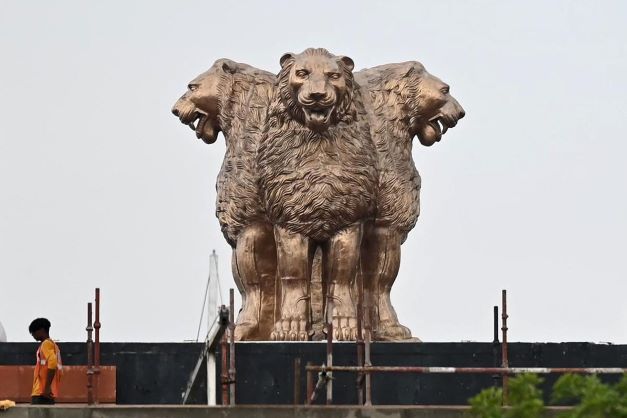“The unveiling of the 6.5-metre high bronze emblem weighing 9,500 kilograms makes for a truly compelling story of the new, aggressive India under a leadership that is soaring high. The world seems to be taking note of it, and its aggressive leader who thinks really big. He so loves to do things differently and is destined to leave his indelible mark,” says veteran journalist Basant Rawat in a satirical piece.
AHMEDABAD—So what if the just unveiled national emblem atop the proposed Parliament building is a ‘bad, inferior’ work of art. After all, it is merely a symbol meant to signal the beginning of a new era. So why all the fuss?
Critics say it is not a true replica of the iconic lions at Ashoka’s pillar in Sarnath. Well, it is not.
It is about the real lion – the political lion from Gujarat – whom some people love to hate and criticize at the slightest opportunity.
A case in point is the central Vista project, an ambitious, dream project that will immortalize him as the modern-day architect of the new, aggressive India.
If you are part of this aggressive bandwagon, then it is time for you to celebrate and not complain.
The unveiling of the 6.5-metre high bronze emblem weighing 9,500 kilograms makes for a truly compelling story of the new, aggressive India under a leadership that is soaring high.
The world seems to be taking note of it, and its aggressive leader who thinks really big. He so loves to do things differently and is destined to leave his indelible mark.
The proposed parliament building is one such project to be opened later this year and is bound to leave an everlasting legacy of this great leader.
Not long ago, he achieved the distinction of being the longest serving head of a province whose denizens came to fondly address him as the lion of the Gurjar nation.
The same lion is now roaring in New Delhi. So, what’s the problem?
Okay, not everybody in the aggressive new nation is in love with his overwhelming, domineering presence.
So, it is understandable if there are people who think the new national emblem is a big deviation from the original – of course, the aggressive government and its acolytes shall deny and counter this charge.
Let the critics call them and their new India angry, insecure, and hence revengeful today. It is bound to happen in a polarised atmosphere helmed by independent India’s most charismatic figure who has singlehandedly transformed the political landscape of this country.
Whatever the unveiling of the new emblem remains a defining moment. Some may call it a symbol of India’s ‘great leap forward’ with a fully open jaw, baring the pointed fangs, etc.
It was never an accident. It is a well-thought-out, well-rehearsed move to announce the new masculine India-led macho politician who also happens to be vying for the title of ‘Universal Guru.’
Ashoka’s lions at Sarnath, the site of the Buddha’s first sermon, were first adopted as the national emblem on January 26, 1950.
Jawhar Sircar, an opposition parliamentarian, shared pictures of the emblem’s old and new versions and said in a tweet that the “original is on the left, graceful, regally confident” while the new version was “snarling, unnecessarily aggressive and disproportionate.”
“Shame! Change it immediately!” he demanded.
Another opposition leader tweeted that the original emblem “has a mild and gentle expression” but the new one “shows a man-eater’s tendency to consume everything in the country.”
A former history professor at MSU in Vadodara wondered if “this tweaking of the national symbol was purely accidental.”
No Sir! Nothing is deliberate, it is well thought out. Nothing on this scale is done in a state of innocence.
In fact, the national emblem has been tweaked to raise it to another level. There is a great vision behind it all.
Another Vadodara-based expert, a well-known sculptor, felt no artist in his right senses would ever deliberately distort a known piece of art.
He is right. The artist behind the distortion must have got a clear brief to do exactly what he ended up doing.
While a few people might deplore the project, there is “absolutely no need to create turmoil or build a narrative” around it, felt a former professor of fine arts in Vadodara.
What happened, happened. So, just leave it. It will only lead to unnecessary, uncalled-for controversy and embarrass the lion…err…leader.
But some people like Jairam Ramesh refuse to listen to this sage advice. “It is nothing but a brazen insult to India’s national symbol!” he tweeted.
But our kind-hearted former professor would like to counsel him with, “Please Sir. After all, this is about New India. No one expects that old national emblem to be restored to its former glory.”
But the detractors won’t stop… There is this leading social activist who insists on removing the new and replacing it with the old – something the leader’s mother organization is very fond of.
This social activist won’t stop. If they refuse to do as he wants, it will only “confirm that this is exactly what they wanted the new emblem to look like.”
Now, what to say? Truth be told…






Very good. Always new.